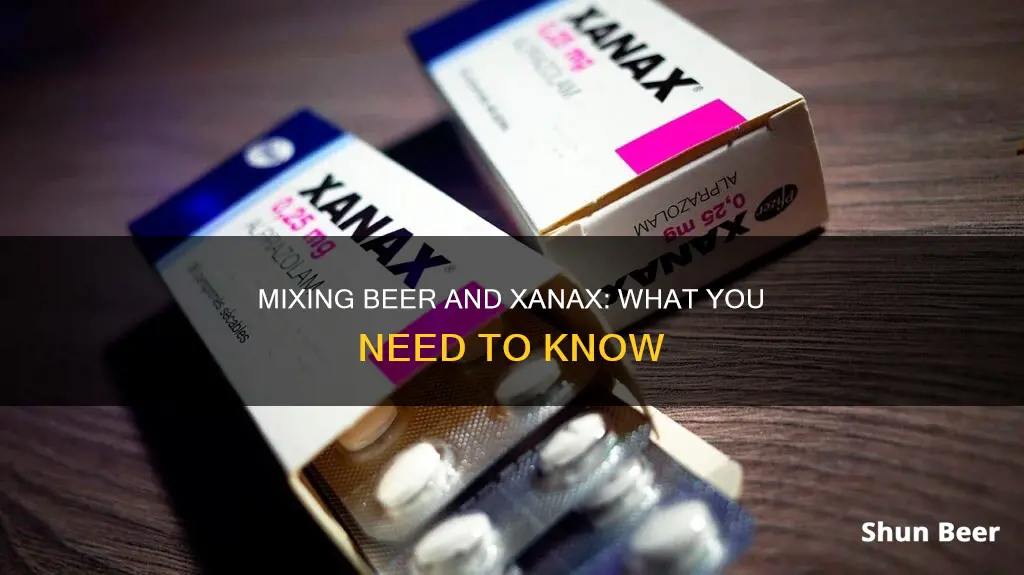
Mixing Xanax and alcohol can be dangerous and even deadly. Both substances have a relaxing effect on the body, and when taken together, they can cause oversedation and even a fatal overdose. Alcohol and Xanax increase the activity of gamma-aminobutyric acid (GABA), an inhibitory neurotransmitter in the brain, resulting in slowed activity in the central nervous system. This combination increases the risk of excessive sedation, dangerous accidents, respiratory depression, cardiac issues, and loss of consciousness. Additionally, the buildup of Xanax in the system due to the body's prioritization of metabolizing alcohol can lead to a dangerous accumulation. While having one beer and a small dose of Xanax may seem harmless, it is important to exercise caution as the effects can be unpredictable and vary across individuals.
| Characteristics | Values |
|---|---|
| Safety | Drinking beer with Xanax is unsafe and can be a deadly mistake |
| Side effects | Increased risk of overdose, slowed or difficulty breathing, impaired motor control, increased sedation and intoxication, increased feelings of hostility, excessive sedation, dangerous accidents, respiratory depression, cardiac issues, loss of consciousness, severe drowsiness, fatigue, weakness, clumsiness, breathing difficulties, behavioural issues, cognitive issues, aggression, irritability, psychosis, neurological effects, physical dependence |
| Recommendation | Experts recommend avoiding taking Xanax and alcohol together |
What You'll Learn

The dangers of drinking beer with Xanax
Mixing Xanax and alcohol can be a deadly combination. While Xanax is a prescription anti-anxiety medication, it is also a benzodiazepine, which means it has a sedative effect. Similarly, alcohol is a sedative that slows down the activity of the central nervous system. When these two substances are mixed, the effects of each drug build upon one another, leading to oversedation and an increased risk of fatal overdose.
Increased Risk of Overdose and Side Effects
Xanax and alcohol affect the levels of gamma-aminobutyric acid (GABA), an inhibitory neurotransmitter in the brain. This increase in GABA activity causes a sedative effect, slowing down the activity of the nervous system. When combined, the effects of Xanax and alcohol are potentiated, leading to excessive sedation, dangerous accidents, respiratory depression, cardiac issues, and loss of consciousness. The risk of overdose is significantly higher when these substances are mixed, and even a small amount of alcohol can lead to severe interactions with Xanax.
Impaired Judgment and Memory
The combination of Xanax and alcohol can impair judgment and memory. This can lead to individuals losing track of how much Xanax they have taken, increasing the risk of an overdose. The intoxicating effects of alcohol can also impair motor control, increasing the risk of motor vehicle accidents and falls.
Cognitive and Psychological Consequences
Chronic use of Xanax and alcohol together can lead to serious cognitive and psychological consequences. Memory problems, depression, sleeplessness, and agitation are common long-term effects of combining these substances. Additionally, there is an increased risk of developing an addiction to both drugs when they are taken together.
Prolonged Detoxification
Xanax and alcohol are metabolized by the same liver enzymes, which means it takes longer for the body to detoxify itself when they are taken together. This results in a dangerous buildup of Xanax in the system, prolonging the presence of both substances in the body.
Increased Potential for Organ Damage
The chronic mixing of Xanax and alcohol places a significant burden on the liver and kidneys, as they work to metabolize and eliminate these substances from the body. This increases the risk of developing liver and kidney damage and disorders compared to using either substance alone.
Mixing Robitussin and Beer: Is it Safe?
You may want to see also

The side effects of drinking beer with Xanax
Drinking beer with Xanax can have a range of side effects, both physical and psychological. Both substances are central nervous system depressants, and when combined, they can cause a dangerous increase in sedation and intoxication. This can lead to respiratory depression, cardiac issues, and loss of consciousness. The risk of accidents, such as motor vehicle crashes, also increases.
The combination of beer and Xanax can also lead to cognitive issues, including memory problems, confusion, and difficulty with critical thinking, problem-solving, and reasoning. It can impair judgement and memory, making it easier to lose track of how much Xanax has been taken, increasing the risk of overdose.
In addition, drinking beer with Xanax can cause fatigue, lethargy, lightheadedness, and increased feelings of hostility, aggression, and irritability. It can also lead to peculiar effects, such as psychosis or neurological issues, including hallucinations and seizures.
The liver prioritizes metabolizing alcohol over Xanax, which means that when taken together, Xanax is eliminated from the body at a slower rate, resulting in a dangerous buildup of the drug in the system. This can further increase the risk of side effects and overdose.
Given these serious side effects, it is generally considered unsafe to drink beer or any other alcoholic beverage while taking Xanax.
Beer and Arrhythmia: Is It Safe to Drink?
You may want to see also

The potential for overdose when drinking beer with Xanax
Drinking beer with Xanax can be a deadly combination. It is important to understand the potential consequences of mixing these two substances to avoid serious health risks, including the possibility of overdose.
Xanax (alprazolam) is a prescription anti-anxiety medication that belongs to the benzodiazepine class of drugs. It is commonly prescribed to treat anxiety, panic disorders, and occasionally alcohol withdrawal or seizures. Benzodiazepines like Xanax act as central nervous system depressants, slowing down nerve activity and producing a calming effect. They facilitate the release of gamma-aminobutyric acid (GABA), an inhibitory neurotransmitter that slows down the activity of the nervous system.
When Xanax is combined with alcohol, the effects of both substances are intensified. Alcohol also has a sedative effect on the body, and when mixed with Xanax, it can lead to oversedation. This occurs because both substances increase the activity of GABA in the brain. As a result, individuals may experience excessive sedation, dangerous accidents, respiratory depression, cardiac issues, and loss of consciousness. The risk of motor vehicle accidents, falls, breathing difficulties, and unintentional death is also significantly increased.
Additionally, the liver prioritizes metabolizing alcohol over Xanax, leading to a slower elimination of Xanax from the body. This can result in a dangerous buildup of Xanax in the system, further increasing the risk of overdose. The combination of Xanax and alcohol can also lead to cognitive issues, aggression, irritability, and psychological consequences such as memory problems, depression, sleeplessness, and agitation.
It is important to note that the effects of mixing Xanax and beer may vary depending on individual factors such as age, liver function, and obesity. However, due to the serious health risks associated with this combination, it is generally recommended to avoid drinking beer or any other form of alcohol while taking Xanax. If you or someone you know is struggling with the misuse of Xanax and alcohol, it is crucial to seek help from a trusted healthcare professional or an addiction treatment facility.
The Magic of Beer Guns: Filling and Foaming Perfection
You may want to see also

The impact on the liver when drinking beer with Xanax
Drinking beer with Xanax can have a detrimental impact on the liver. Both substances are broken down by the same liver enzymes, which means it takes longer for them to be flushed out of the body. This results in the substances lingering in your system for a more extended period, increasing the intensity of their effects.
Xanax is a prescription medication used to treat anxiety and panic disorders. It belongs to a class of drugs called benzodiazepines, which act on the central nervous system to produce a calming effect. Alcohol, on the other hand, is a depressant that also has a sedative effect on the body. When combined, the two substances can cause oversedation and even lead to a fatal overdose.
The liver is responsible for metabolizing drugs and toxins, and when Xanax and alcohol are taken together, they compete for the same metabolic pathways in the liver. This means that the liver has to work harder and may become overwhelmed, leading to potential liver damage. Additionally, the increased workload on the liver can cause a buildup of toxins in the body, further exacerbating the negative effects.
The combination of Xanax and alcohol can also increase the risk of respiratory depression, cardiac issues, and loss of consciousness. It can also lead to memory problems, depression, sleeplessness, and agitation. Therefore, it is strongly advised to avoid drinking beer or any other alcoholic beverage while taking Xanax to minimize the risk of adverse effects and potential liver damage.
Furthermore, it is worth noting that Xanax has a high potential for abuse and addiction, especially when combined with alcohol. Mixing the two substances can impair judgment and memory, making it easy to lose track of how much Xanax has been consumed, increasing the risk of an overdose. Therefore, it is crucial to follow the prescribed dosage and avoid mixing Xanax with alcohol to mitigate the impact on the liver and reduce the risk of other harmful consequences.
Pilsner Glasses: Best Beers to Enjoy in This Glassware
You may want to see also

The addictive nature of Xanax and alcohol
Xanax is a highly addictive prescription drug. It is a benzodiazepine, which is a class of drugs that acts as a central nervous system depressant. It is often prescribed to treat anxiety, panic disorders, insomnia, nausea caused by chemotherapy, and depression. Benzodiazepines are typically classified as Schedule IV controlled substances, indicating a low to moderate potential for abuse and the development of physical dependence. However, despite its intended purpose as a safer alternative to Valium, thousands seek treatment for Xanax dependence every year.
Xanax is particularly dangerous when mixed with other drugs, especially alcohol. This is because both substances are central nervous system depressants, meaning they slow down the activity of the central nervous system and produce a calming effect. When taken together, they can cause oversedation and even lead to a fatal overdose. The risk of overdose is further increased when Xanax is abused in conjunction with alcohol, as the liver prioritises metabolising alcohol over Xanax, leading to a dangerous buildup of Xanax in the system.
The combination of Xanax and alcohol also results in a range of other dangerous side effects, including respiratory depression, cardiac issues, loss of consciousness, fatigue, aggression, cognitive issues, and increased potential for psychosis or neurological effects. The synergistic effects of the two substances can also lead to a buildup of inhibitory neurotransmitters, causing difficulty in forming new memories and potentially resulting in blackouts.
The addictive nature of Xanax is evident in the development of tolerance and withdrawal symptoms. Users may find that Xanax stops working as effectively over time, leading them to increase their dosage to achieve the desired effects. When attempting to quit, they may experience withdrawal effects such as anxiety, restlessness, insomnia, tremors, headaches, nausea, vomiting, convulsions, and more.
The highly addictive nature of Xanax, coupled with the dangerous side effects of mixing it with alcohol, underscores the importance of using this drug only under medical supervision and avoiding concurrent alcohol consumption.
Beer and Azithromycin: What You Should Know
You may want to see also
Frequently asked questions
It is not recommended to mix Xanax and alcohol. Both substances have a relaxing effect on the body and can become dangerous when taken together, causing oversedation and even fatal overdose.
When taken together, the side effects of Xanax and alcohol include:
- Excessive sedation
- Dangerous accidents
- Respiratory depression
- Cardiac issues
- Loss of consciousness
- Memory problems
- Depression
- Sleeplessness
- Agitation
It is recommended to wait until most of the Xanax has cleared your system before consuming alcohol. The half-life of Xanax is 11.2 hours, and it takes about 56 hours on average for a single dose to be removed from the body. However, this time may vary depending on factors such as age, liver function, and obesity.
While it is generally advised to avoid mixing any benzodiazepines with alcohol, some people report drinking beer with Valium (diazepam), another benzodiazepine, without experiencing harmful effects. However, it is important to note that everyone's physiology is different, and mixing any central nervous system depressants can be dangerous.







